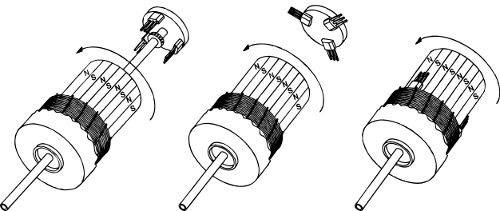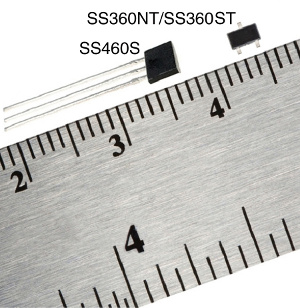 |
| July 23, 2013 | Volume 09 Issue 28 |
Designfax weekly eMagazine
Archives
Partners
Manufacturing Center
Product Spotlight
Modern Applications News
Metalworking Ideas For
Today's Job Shops
Tooling and Production
Strategies for large
metalworking plants
Engineer's Toolbox:
Motor tech -- Why chopper stabilization isn't needed for Hall-effect sensors
By Joshua Edberg and Fred Hintz, Honeywell Sensing and Control
Magnetic sensor manufacturers can meet high-sensitivity and magnetic-stability requirements for brushless DC (BLDC) motor applications without using chopper stabilization, thanks to new technologies and processes. Traditionally, sensor manufacturers have met these requirements by using chopper stabilization, a technique used to mitigate sensitivity and stability over temperature issues, in the manufacture of latching Hall-effect sensors.
BLDC motors are generally known to be highly efficient and have grown in popularity as demand continues to increase for energy-efficient products. These motors use electronic commutation to control the power distribution to the motor. Latching Hall-effect sensors are used in BLDCs to measure the motor's position, which is communicated to the electronic controller to spin the motor at the right time and right orientation. BLDC motors target applications that need an efficient and quiet motor, including robotics, portable medical equipment, HVAC fans, and appliances.

Latching Hall-effect sensors can be placed at the end of a motor's shaft, around a ring magnet attached to the rotor shaft, or directly inside the motor.
Typically, BLDC motor manufacturers select chopper-stabilized latching sensors for electronic commutation, knowing that these sensors generally provide higher sensitivity. However, what they are looking for is a high-sensitivity part that is stable over its specified temperature range.
Designers formerly selected a chopper-stabilized latching Hall-effect sensor for three reasons: It was an ideal technology for BLDC motors; it was needed to achieve stability over the operating temperature range; and it was the only way to achieve high sensitivity.
We'll take a look at why these reasons aren't entirely true anymore due to newer sensing options that can commutate the motor more efficiently.
Chopper stabilization was an ideal technology
Historically, designers have believed that chopper stabilization was an ideal technology for latching sensors in BLDC motors. While it's true that chopper stabilization offers high sensitivity and more magnetic stability, it also has several disadvantages, including slower response time, greater accuracy errors (due to sampling), and more electrical noise.
Hall-effect or magnetic sensors measure change in magnetic field and communicate the position of the motor shaft to an electronic controller, which uses the data to determine when to apply the current to the motor coils to make the magnets rotate at the right orientation. The rotor's position needs to be measured as accurately as possible to have a highly efficient motor. However, the longer it takes for the sensor to respond to the changes in magnetic field, the less accurate this position is. This may result in poor motor efficiency.
The problem with chopper stabilization is that it requires a continual averaging of the induced voltage across the Hall elements to determine the output signal, which slows down how fast a sensor switches. This means chopper-stabilized parts typically switch at a delayed magnetic field level due to the slower switching or response. In addition, the delay time of the chopper-stabilized device results in greater accuracy errors as the motor spins faster.
Chopper stabilization also adds electrical noise to the circuit, which translates into additional design time, more filtering, and, ultimately, a higher cost.
In comparison, a latching sensor without chopper stabilization delivers a faster response time. Since the motor is commutated at or closer to the correct time, this translates into higher accuracy, which leads to a more efficient motor. A non-chopper-stabilized sensor also doesn't generate additional electrical noise, which eliminates the need for additional filtering and simplifies the design.
Chopper stabilization was required for stability
Designers also traditionally thought that chopper stabilization was the only technique for achieving stability over the operating temperature range of a Hall-effect sensor.
There is a general misconception in the industry that non-chopper-stabilized parts are not stable. One of the most important factors contributing to the stability of the sensor starts with the Hall element used by the manufacturer. If a manufacturer starts with a more stable Hall-effect element, such as a quad Hall element, it will result in a much more stable product.
However, many sensor manufacturers utilize single and dual Hall-effect elements, which are susceptible to wide ranges of magnetic performance due to packaging stresses. This has resulted in the use of chopper stabilization (using an averaging process) to provide a more stable operation over voltage and temperature.
Sensor manufacturers can produce higher stability parts without chopper stabilization with the use of a quad Hall element, which is less susceptible to stress-induced error because the voltage is measured in four directions. This cancels the offsets in each element to provide stable operation over the operating temperature range. And it doesn't make the package any larger than its single or dual Hall-element counterparts.
Chopper stabilization was the only way to achieve high sensitivity
Traditionally, designers have believed that stabilization is required to achieve high sensitivity in latching Hall-effect sensors for BLDC motor commutation. While it's true that the technique does provide high sensitivity, it's not the only way to achieve it. Sensor manufacturers are using other technologies and processes to produce high sensitivity, faster response times, and higher repeatability.
Honeywell Sensing and Control, for example, has developed a high-sensitivity latching sensor that utilizes a quad Hall element and proprietary programming without chopper stabilization. While the quad Hall element provides higher stability, the programming contributes to the high sensitivity of the sensor by adjusting the magnetics to account for the effects of packaging stresses. This high sensitivity and stable magnetics, combined with a faster response time, higher repeatability, improved jitter performance (which is critical for BLDC efficiency), and no additional electrical noise generation, make the new device well suited for BLDC motors.

Honeywell bipolar latching Hall effect sensors provide the precise motor shaft positioning data needed by BLDC motors.
The Honeywell SS360NT/SS360ST/SS460S latching Hall-effect sensors provide high magnetic sensitivity of 30 Gauss (G) typical (55 G maximum) over the entire temperature range of -40 deg C to 150 deg C. These Hall-effect sensors can significantly contribute to higher motor efficiency with a faster latch response time and the capability to handle higher frequencies. Initial customer feedback shows a 5 percent increase in motor efficiency compared to a competitive chopper-stabilized part.
When selecting a highly sensitive latching Hall-effect sensor for a BLDC motor, design engineers should consider the drawbacks of using chopper stabilization and evaluate newer technologies and sensing devices that don't use the technique in order to design the most efficient motor for their customers.
About the authors
Joshua Edberg is senior global marketing manager in the Magnetic Sensors division at Honeywell Sensing and Control. Contact Joshua at Joshua.edberg@honeywell.com.
Fred Hintz is engineering manager in the Speed and Position Sensors division at Honeywell Sensing and Control.
For more information, go to Honeywell Sensing and Control.
Rate this article
View our terms of use and privacy policy
